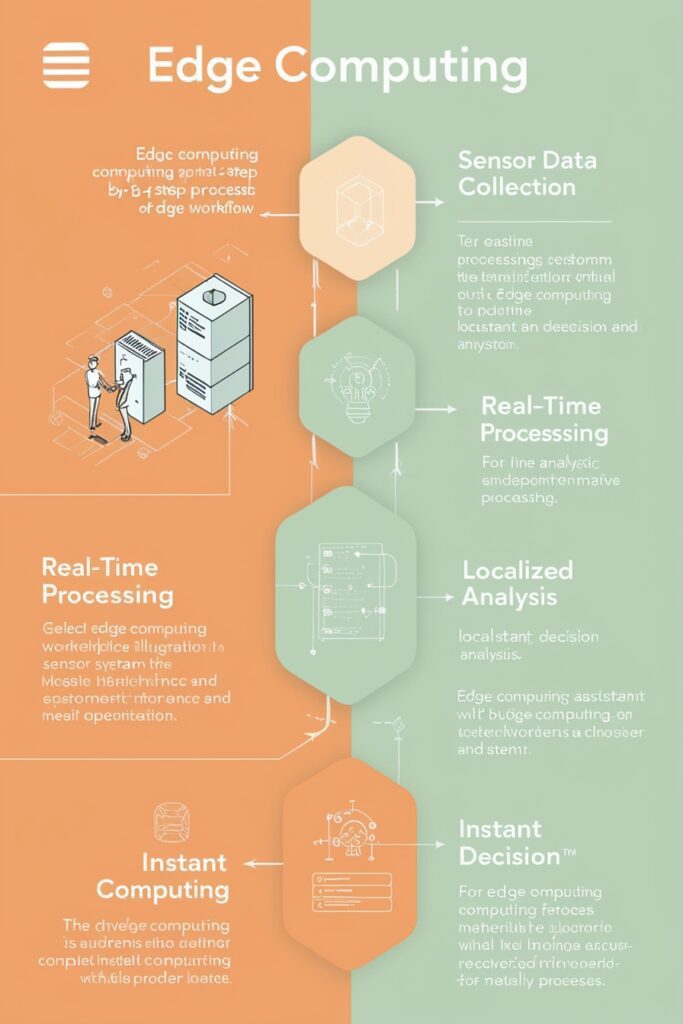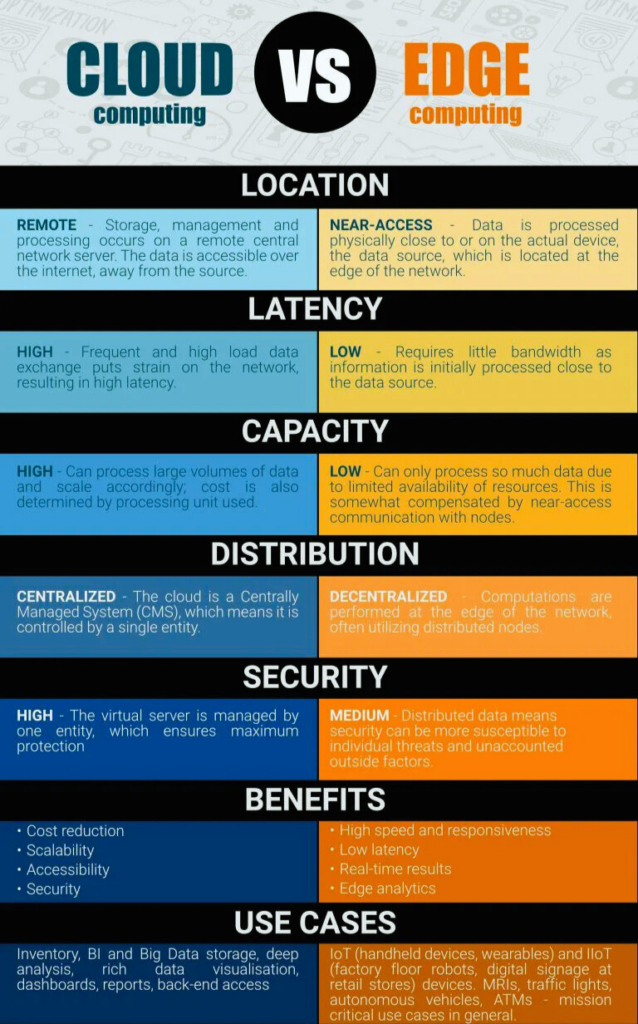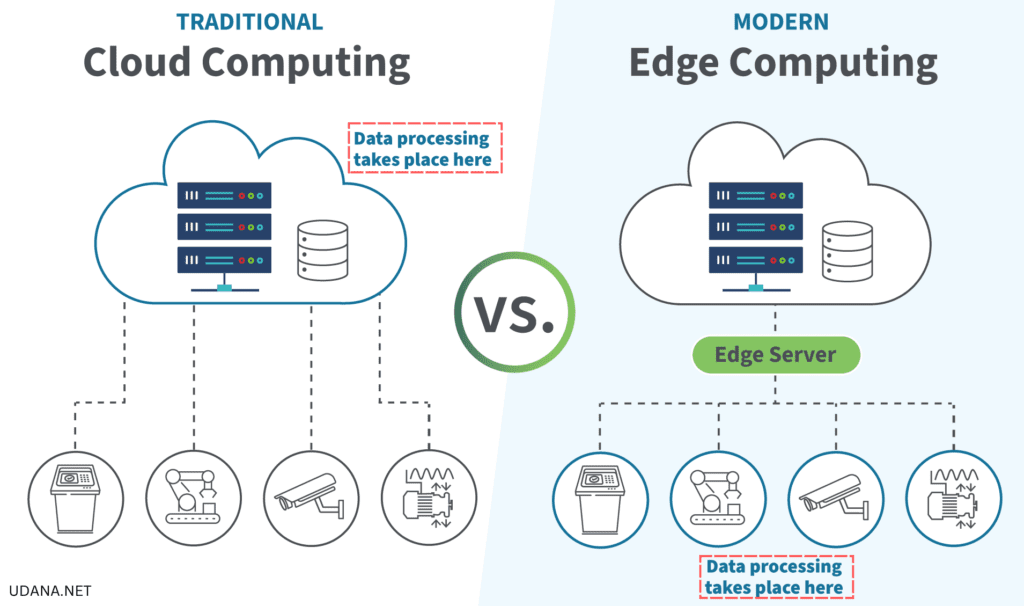Table of Contents
What are Data Processing Paradigms
Data processing paradigms refer to the methods or frameworks we use to acquire, store, and analyse data. Traditionally, data was processed in a centralised system, which collects and processes data in a single location, such as a data centre. Cloud computing transformed this concept by providing remote data centres that manage enormous volumes of data from multiple places.
Cloud-based data processing enables organisations to access strong computational resources on demand, making it perfect for large-scale data analysis, artificial intelligence, and machine learning applications. However, because of the latency required in sending data back and forth to a central server, cloud computing isn’t necessarily appropriate for applications that require quick answers, such as real-time monitoring or autonomous driving.
The era of edge computing has been proposed as a new paradigm for data processing in recent years, which overcomes the shortcomings of cloud computing especially on application execution requiring low-latency responses. Edge computing processes data closer to the point it was generated, such as in local devices or nearby servers. This distributed method is essential to reduce latency costs in IoT and AR as well as any other messaging or real-time services.
Modern companies with diverse requirements are moving to the cloud, but most of them — from SMBs and up — will benefit best by adopting a hybrid model that harnessing reliable adaptable scalable processing capabilities and low-latency performance. All in all, these paradigms are moving towards a future where data processing can be more easily tailored to individual application demands.
What is Cloud Computing? 🌥️
Cloud computing is a concept for providing computing services via the internet. IT gives users on-demand access to a shared pool of configurable computing resources (such as networks, servers, storage, applications, and services) that can be quickly deployed and released with minimal administration effort. Users can access these resources remotely and pay only for what they use.
These services obviate the need for businesses to invest in and manage their own physical servers and data centres. Instead, organisations can hire virtual resources, which can be readily scaled up or down to meet their specific needs. This elasticity leads into substantial cost savings and increased agility. The accumulation of data in centralised areas leads to vulnerable points of failure. A natural disaster or cybercrime might disrupt vital operations, causing businesses to scramble for a backup plan. Could a more distributed strategy, with data spread around the globe, provide better security and resilience?
Understanding Edge Computing 🌐
It’s possible that your business is growing quickly, and you need to handle huge amounts of data quickly and safely. Cloud computing has a lot of resources, but edge computing brings the processing power closer to the data source. Which should you use? In this digital age, this choice is very important for getting the best speed, cost, and security, and it starts the edge computing vs. cloud computing debate.
Several researchers say that by 2025, 75% of the data created by businesses will be stored somewhere other than standard centralised data centres or the cloud. This is up from less than 10% in 2018. You can make the best choice for your business if you know the main differences and perks between edge computing and cloud computing. The best computing model for your business will depend on a number of factors.

Key Differences: Edge Computing vs Cloud Computing 💻
📌 Data Processing Location and Method
Cloud Computing: Data is sent to centralised cloud data centres over the internet, where it is handled. This may require a lot of data to be moved, which can slow things down and cause delays, based on where the data centres are in relation to the data source.
Edge Computing: There are edge devices, like sensors or local edge servers, that handle data close to where it is created. Because they are close, data can be processed right away without having to be sent to a central place.
📌 Latency and Response Time
Cloud Computing: The latency that comes with sending and receiving data in and out of the cloud can make it impossible for real-time apps to work. It can be used for tasks where working in batches is fine or where response time in real time is not important.
Edge Computing: Because it reduces latency, it’s perfect for real-time applications that need to handle data right away. This is very important in situations like self-driving cars, managing traffic in real time, and emergency reaction apps.
📌 Cost Implications
Cloud Computing: Provides a pay-as-you-go plan that can be a cost-effective way to expand operations without having to buy new hardware up front. Costs can add up, though, as the amount of data that needs to be sent and stored grows.
Edge Computing: Since less data is sent to the cloud, costs linked to data transmission and bandwidth use can go down. It also cuts down on the need for expensive centralised data handling.
📌 Scalability
Cloud Computing: Extremely flexible; resources can be added or taken away based on demand. This adaptability is a big plus for companies whose work loads change often.
Edge Computing: Adding more edge devices and improving local computing resources are part of scaling, but they can be restricted by physical and logistical issues.
📌 Security and Compliance
Cloud Computing: Strong security steps put in place by cloud service providers, such as advanced encryption and security protocols. But putting data in one place can make it easier for hackers to get to, and it can be hard to follow the rules when data is stored in different places.
Edge Computing: Offers better security because data is processed locally, which means it is less vulnerable to threats while it is being sent. However, each edge gadget can also be a security risk if it is not properly protected.
📌 Connectivity Dependency
Cloud Computing: You need to be connected to the internet all the time to access cloud services, which can be a problem in places with bad connectivity.
Edge Computing: Because it doesn’t depend on a central cloud, it can work well in places with little or no internet access. This is especially helpful when the network is far away or unreliable.

Use Cases Best Suited for Cloud Computing
- Big Data Analytics: Cloud computing provides the storage and processing resources to perform fast analytical on big data. It works out nicely for businesses depending on data analytics, say an e-commerce platform applying customer insights to target the marketing.
- Software as a Service (SaaS): SaaS applications are built on cloud computing platforms, allowing software producers to deliver services through the internet. Applications like Microsoft 365, Google Workspace, and Salesforce that users can access anytime without the need to manage local installations
- AI and Machine Learning: Cloud Computing Facilities helps both the Deep workloads required to train as well infer intelligent AI and machine learning models, at any scale. One of the salient characteristic is that its accompanied by ready-made tools and GPUs to help eaze in model training and deployment such as Google Cloud AI, AWS SageMaker or Azure Machine Learning etc.
- E-commerce Platforms: E-Commerce businesses use Cloud Computing to deal with traffic surges, handle secure payment processing and store customer data. When the holiday season approaches, this flexibility enables customers to experience their services with zero delay thanks to cloud scalability.
- Disaster Recovery and Backup: Disaster and Backup Recovery – Cloud-based disaster recovery solutions offer a cost-effective, reliable way for your organization to back up their critical data offsite. Which is quick recovery for such data losses or natural disasters which could even be costly on-premise setup.
- Web Hosting and Content Delivery: Web Hosting and Content Delivery : Websites, online services and content-heavy applications can use cloud computing for hosting. Cloud providers, Including AWS and Azure, also provide certain levels of load balancing as well as broader global presence to enhance content delivery with low latency and high availability.
Use Cases Best Suited for Edge Computing 👈
- Autonomous Vehicles: To make self driving cars create decisions based on on obstacle detection and navigation in real time without cloud based latency, edge computing is the method used by such self driving cars to process huge amounts of sensor data in real time.
- Content Delivery Networks (CDNs): Edge computing drastically reduces load times for media streaming, gaming and web applications by caching content close to end users resulting in fast delivery without requiring existing corporate infrastructure.
- Energy Management and Smart Grid: Edge computing processes data from energy sensors, as well as the information found on distribution systems themselves, in a location agnostic manner that is not tied to centralized cloud infrastructure. Beyond allowing for better management of our energy loads by reducing waste just-in-time consumption patterns (which are vital during times when we need them most), changes occurring within these established grids can be acted upon with next-to-no latency thanks top this same kind where they change trigger sizes over time based solely around how powerlines meet new demands or start exposing vulnerabilities!
- In Agriculture Technology: Edge computing done by the sensors of soil monitoring where edge do in drone image processing or weather data through prognosticate information for transforming into water release calculation provides an increased version precision agriculture.
- There is also remote industrial sites: for industries with everyone else would have to travel long distances just to access some kind of same, oil rigs or mining operations, edge computing empowers on-site data processing and permits continuous monitoring.
- Smart Cities: By processing data locally in proximity to where it is being used, edge computing enables citywide systems like traffic monitoring, waste and public safety, while affording insights just seconds after data capture, reducing congestion and improving urban planning.
- Industrial IoT and Predictive Maintenance: Edge computing enables predictive maintenance in manufacturing by processing data from machines on the edge, detecting anomalies early before machines break down and release costly breakdowns and reduce downtime.
- Healthcare and Remote Patient Monitoring: Real time patient monitoring in healthcare by edge computing enables processing of data from wearable devices and hospital equipment locally for instant alerting of healthcare providers to boost patient care and response times.
- Augmented Reality (AR) and Virtual Reality (VR): For AR and VR applications, ultra low latency is essential for the seamless avatar presentation, be it in gaming, training, or remote collaboration and edge computing is a perfect fit as a solution to process locally and remain responsive.
- Retail and Customer Analytics: Edge computing powers retailers to decipher shopper behavior in real time – through sensors and cameras – for more personalized marketing, more efficient inventory management, and features that enhance in-store experience.
Hybrid Network: Combining Cloud Computing and Edge Computing 🔋
When you combine cloud computing and edge computing, you get a mixed network that uses the best parts of both to make solutions that are more efficient and adaptable. When you have a hybrid network, data and apps can be handled in the cloud or on edge devices, depending on what you need. This lets you improve operational efficiency, boost speed, and cut down on latency.
Hybrid networks usually have designs that include a few key parts, such as:
- Edge Nodes: Local devices or servers that perform data processing near its source, such as IoT devices, routers, and gateways
- Cloud Central: The part of the network that provides large storage capacity, data analysis, and other cloud-based services.
- Network Connectivity: The network that connects the cloud central with edge nodes, enabling efficient data transfer and synchronization.
Many important benefits and advantages are gained by businesses and organisations that use mixed networks. Here are some of the benefits:
Using multiple layers to protect data better: By processing data at edge points, you can lower the security risks that come with sending data to the cloud. It is possible to process and keep sensitive data locally, and it is also possible to send less sensitive data to the cloud to be analysed further. This multi-layered method makes privacy and security of data better.
Optimising performance and operational efficiency: When you combine cloud and edge computing, you can make sure that data that needs to be processed quickly is handled at edge nodes and data that needs a lot of storing space or complex analysis is handled in the cloud. This improves speed and efficiency all around.
Being Flexible and Adaptable to Business Needs: Hybrid networks make it easy to change your IT systems to meet new business needs. You can also use the flexibility of cloud computing to handle high demand and edge computing for tasks that need to be done quickly.
By using hybrid networks, businesses can get the most out of both technologies, make operations more efficient, and make sure that different apps run at their best. When the business world is always changing, flexible networks give companies the freedom to stay competitive and respond to changes in the market.
The Future of Decentralized Data Processing 🌱
🟩 Decentralization As A Driving Force
For decades, centralised systems have been the norm in technology. Now, decentralised models are taking their place, which has many benefits.
Decentralisation can help improve security, make networks more resilient, and cut down on single points of failure. As an example, blockchain technology uses a decentralised ledger system to make deals safe and clear without the need for a central authority.
This change is affecting more than just finance. It is also being used in healthcare, supply chain management, and other fields. This shows how widespread the effects of distributed technologies are. Blockchain is thought to save banks over $27 billion by 2030.
🟩 The Rise Of Edge Computing
In edge computing, data is processed at the “edge” of the network, closer to where it is created, instead of on a central computer. This method cuts down on latency and bandwidth use, and it improves the performance of apps that need to process data right away, like smart cities, collaborative robots in factories, and fast financial processing.
Edge clouds today happen on-site at businesses, but as the costs of computing and storage go down, businesses that switch to public edge clouds can save money.
🟩 Distributed Artificial Intelligence
Centralized data centers are used by traditional AI systems to train models and process data. But AI’s future is becoming more spread out, with AI programs being used on edge devices and in decentralized networks. This change makes it possible to make decisions in real time and cuts down on the need to send large amounts of data to centralized GPUs.
Distributed AI is important in situations where decisions need to be made right away, like with self-driving cars, and where data privacy is a worry. Elon Musk at Tesla has suggested that AI work could be spread across the cars’ spare computing power, which I think is a great example.
I’m sure that the need for more reliable, safe, and effective methods will lead to the future of technology being distributed. Even though there are still some problems, distributed technology has a lot of possible benefits, such as new ways to innovate, give people more power, and grow the economy. In the future, it will be important to follow distribution rules in order to get the most out of new technologies.
FAQ 💡
What is the main difference between edge computing and cloud computing?
Edge computing processes data closer to the source (at the “edge” of the network), while cloud computing relies on centralized data centers for processing and storage.
How does edge computing improve data processing speed?
By processing data locally near the source, edge computing reduces latency and enables real-time decision-making, making it ideal for time-sensitive applications.
What are the advantages of cloud computing over edge computing?
Cloud computing offers scalability, centralized management, and cost-efficiency for storing and processing large volumes of data.
Why is data decentralization important in edge computing?
Data decentralization in edge computing enhances security, reduces bandwidth usage, and ensures faster response times by minimizing reliance on centralized servers.
Which industries benefit most from edge computing?
Industries like healthcare, manufacturing, autonomous vehicles, and IoT benefit from edge computing due to its low latency and real-time processing capabilities.
Can edge computing and cloud computing work together?
Yes, they can complement each other. Edge computing handles real-time processing, while cloud computing manages large-scale data storage and complex analytics.
What are the security implications of edge computing?
Edge computing reduces the risk of data breaches by limiting data transmission, but it requires robust security measures at each edge device to prevent local vulnerabilities.
How does edge computing support IoT devices?
Edge computing enables IoT devices to process data locally, reducing latency, improving efficiency, and ensuring seamless operation even with limited connectivity.


